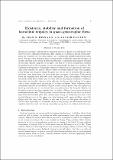Existence, stability and formation of baroclinic tripoles in quasi-geostrophic flows
Abstract
Hetons are baroclinic vortices able to transport tracers or species, which have been observed at sea. This paper studies the offset collision of two identical hetons, often resulting in the formation of a baroclinic tripole, in a continuously stratified quasi-geostrophic model. This process is of interest since it (temporarily or definitely) stops the transport of tracers contained in the hetons. First, the structure, stationarity and nonlinear stability of baroclinic tripoles composed of an upper core and two lower (symmetric) satellites are studied analytically for point vortices and numerically for finite-area vortices. The condition for stationarity of the point vortices is obtained and it is proven that the baroclinic point tripoles are neutral. Finite-volume stationary tripoles exist with marginal states having very elongated (figure-of-eight shaped) upper cores. In the case of vertically distant upper and lower cores, the latter can nearly join near the centre of the plane. These steady states are compared with their two-layer counterparts. Then, the nonlinear evolution of the steady states shows when they are often neutral (showing an oscillatory evolution); when they are unstable, they can either split into two hetons (by breaking of the upper core) or form a single heton (by merger of the lower satellites). These evolutions reflect the linearly unstable modes which can grow on the vorticity poles. Very tall tripoles can break up vertically due to the vertical shear mutually induced by the poles. Finally, the formation of such baroclinic tripoles from the offset collision of two identical hetons is investigated numerically. This formation occurs for hetons offset by less than the internal separation between their poles. The velocity shear during the interaction can lead to substantial filamentation by the upper core, thus forming small upper satellites, vertically aligned with the lower ones. Finally, in the case of close and flat poles, this shear (or the baroclinic instability of the tripole) can be strong enough that the formed baroclinic tripole is short-lived and that hetons eventually emerge from the collision and drift away.
Citation
Reinaud , J N & Carton , X 2015 , ' Existence, stability and formation of baroclinic tripoles in quasi-geostrophic flows ' , Journal of Fluid Mechanics , vol. 785 , pp. 1-30 . https://doi.org/10.1017/jfm.2015.614
Publication
Journal of Fluid Mechanics
Status
Peer reviewed
ISSN
0022-1120Type
Journal article
Collections
Items in the St Andrews Research Repository are protected by copyright, with all rights reserved, unless otherwise indicated.

